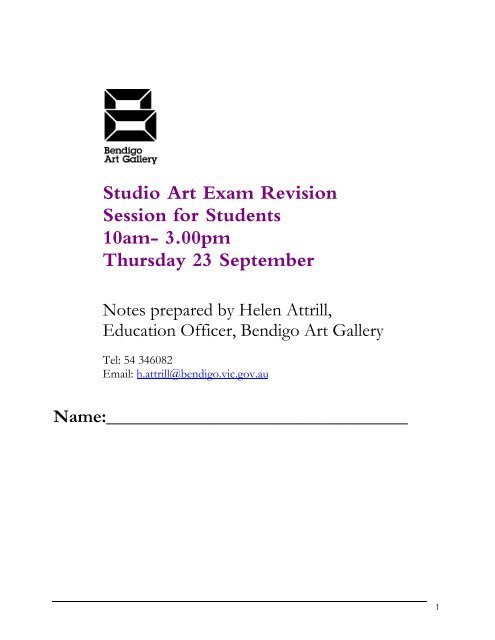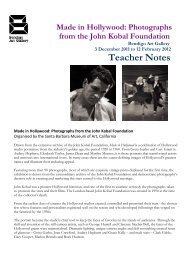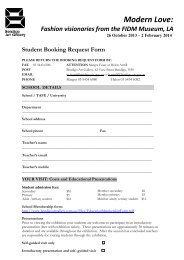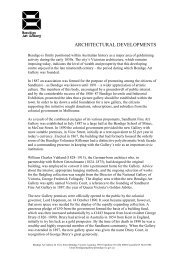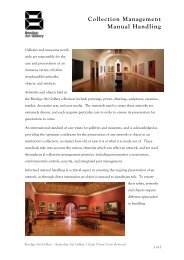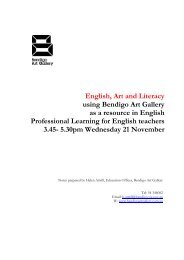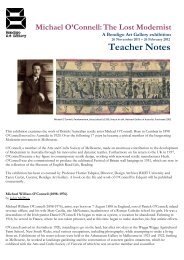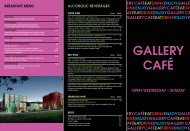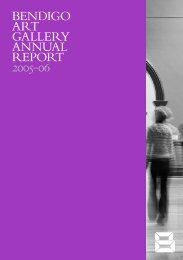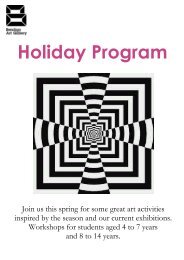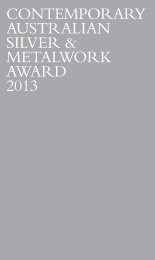Studio Arts Exam Revision booklet - Bendigo Art Gallery
Studio Arts Exam Revision booklet - Bendigo Art Gallery
Studio Arts Exam Revision booklet - Bendigo Art Gallery
You also want an ePaper? Increase the reach of your titles
YUMPU automatically turns print PDFs into web optimized ePapers that Google loves.
<strong>Studio</strong> <strong>Art</strong> <strong>Exam</strong> <strong>Revision</strong><br />
Session for Students<br />
10am- 3.00pm<br />
Thursday 23 September<br />
Notes prepared by Helen Attrill,<br />
Education Officer, <strong>Bendigo</strong> <strong>Art</strong> <strong>Gallery</strong><br />
Tel: 54 346082<br />
Email: h.attrill@bendigo.vic.gov.au<br />
Name:_________________________________<br />
1
Plan<br />
10.00-10.30 Walk to Auditorium Visual <strong><strong>Art</strong>s</strong> Centre, 121 View Street, <strong>Bendigo</strong> (across the road<br />
from <strong>Bendigo</strong> <strong>Art</strong> <strong>Gallery</strong>)<br />
What to expect in a <strong>Studio</strong> <strong><strong>Art</strong>s</strong> exam:<br />
View example of practice exam and learn about structure and content<br />
10.30-10.45 Conservation: look at images of storage; revise points such as lighting, humidity, storage, pest<br />
control – powerpoint<br />
10.45-11.00 Break and view Visual <strong><strong>Art</strong>s</strong> Centre exhibitions<br />
11.00-11.30 Noah Grosz, Technician and artist<br />
Conservation and <strong>Art</strong>ist Intention/ Ephemeral <strong>Art</strong><br />
Discussion of installation of Kerrie Poliness’ Blue Wall Drawing #1 and acquisition of Noah<br />
Grosz’s Blockie<br />
11.30-12.00 Tansy Curtin, Curator – how appropriation relates to art galleries; case studies; licensing<br />
agreements, fair trading and moral rights<br />
12.00-12.30 Sponsorship, Publicity and marketing<br />
Case Studies: McCubbin and Couture examples<br />
12.30-12.45 Different types of <strong>Art</strong> Galleries<br />
12.45-1.30 Lunch in Sculpture Court, <strong>Bendigo</strong> <strong>Art</strong> <strong>Gallery</strong> and free exhibition viewing<br />
1.30-1.45 optional: look at conservation items – Australian <strong>Art</strong> 3 room<br />
(turn left at 1 st contemporary art room and keep walking until you see the trolley)<br />
view conservation items: revise and view examples of materials such as different gloves, solander<br />
boxes, storage materials, light meter.<br />
1.45-2.15 all meet in Australian <strong>Art</strong> 3 room<br />
Tour of <strong>Gallery</strong> with Helen Attrill; compare exhibition design and display of the different rooms;<br />
history of <strong>Gallery</strong>; how artworks are acquired at <strong>Bendigo</strong> <strong>Art</strong> <strong>Gallery</strong>; conservation requirements in<br />
different rooms.<br />
OPTIONAL WORKSHOPS:<br />
2.20-2.50 Exhibition Design: view a current exhibition and learn about methods used to maximise impact<br />
on the audience. Paul Guest Prize with Tansy Curtin, Curator<br />
Or<br />
The role of public and other galleries – optional: walk to Allans Walk <strong>Art</strong>ist Run Space<br />
with Helen Attrill; meet the Volunteer Coordinator; view current exhibition<br />
2.50- 3.00 OPTIONAL: question time – AA3<br />
Helen will be available if you have any further questions<br />
2
<strong>Bendigo</strong> <strong>Art</strong> <strong>Gallery</strong><br />
Mission Statement<br />
<strong>Bendigo</strong> <strong>Art</strong> <strong>Gallery</strong> is a permanent establishment administered in the public<br />
interest whose primary functions are to collect, preserve and display works of art<br />
and to elucidate their history and background for the pleasure and education of<br />
the public.<br />
The <strong>Gallery</strong> carries out this task by performing the following primary functions as<br />
ends in themselves:-<br />
1. To acquire appropriate works of art for its collection.<br />
2. To ensure that works for which it is responsible are adequately housed,<br />
documented and cared for.<br />
3. To display its collections to their fullest advantage.<br />
4. To supplement museum owned material with exhibitions and loans from<br />
other sources.<br />
5. To expand public understanding of art.<br />
6. To ensure that the premises are accessible to the public and are safe and<br />
attractively maintained.<br />
7. To provide an appropriate level of ancillary services, such as shops,<br />
restaurants and public programs which will attract the public and increase<br />
its enjoyment and understanding of the <strong>Gallery</strong> and its purposes.<br />
In order to perform these functions effectively, a <strong>Gallery</strong> may also concentrate on<br />
other areas such as the following, as means to the ends listed above.<br />
A. To encourage the active development of staff skills and professional<br />
expertise.<br />
B. To publicise its activities so as to maintain a high level of attendance.<br />
C. To provide research facilities and services to document works and to offer<br />
source material primarily for educational programs and publications.<br />
D. To raise funds for <strong>Gallery</strong> purposes.<br />
E. To maintain a positive relationship with individuals and organisations both<br />
public and private, which are relevant to the <strong>Gallery</strong>.<br />
3
<strong>Exam</strong>ination Criteria:<br />
From http://www.vcaa.vic.edu.au/vcaa/vce/studies/studioarts/publications/studarts-sampw.pdf<br />
Notes about examination structure and content:<br />
4
Conservation at <strong>Bendigo</strong> <strong>Art</strong> <strong>Gallery</strong><br />
1. Humidity<br />
What is it ?<br />
Humidity is the percentage of water found as vapour in any given volume<br />
in the air.<br />
The ideal climate for most materials is between 50%+/- 5% relative humidity<br />
Below 45% organic materials such as wood/leather/ animal glue & shell all become brittle, dry out<br />
and may split or warp.<br />
Above 65% mould will grow, veneers will detach/ metals may corrode and paint may flake.<br />
With the above extremes the changes can magnify with material combinations due to the different<br />
stress levels of materials.<br />
Wood/paint = wood expands or contracts, paint flakes (most acrylic/oil paintings – 19 th century)<br />
Wood/textile = textiles become stained/ brittle<br />
Metal/paper = metal corrodes, paper becomes stained (modern photography such as Bill Henson<br />
often use aluminum as a backing to photographic works)<br />
More dangerous than constantly high or low RH is a constantly fluctuating RH. If organic objects are<br />
constantly absorbing and de-absorbing moisture, or shrinking and growing the object will split,<br />
buckle and paint will flake.<br />
2. Temperature<br />
The optimum is 20 C+/- 2 C, this is also the international standard.<br />
Like the humidity this is monitored and controlled by a computer run database system onsite, and<br />
can give out graphs on the last 12 months of readings. The system takes readings every 15<br />
minutes.<br />
Long exposure outside of the optimum temperature will result in the following possible reactions;<br />
Paper, textiles, lacquer, leather, natural fibres, bone, wood and paint can become embrittled and<br />
darken.<br />
Rubber can crumble .<br />
Celluloid can yellow.<br />
Higher temps will speed up natural decaying reactions.<br />
<strong>Revision</strong>: When did <strong>Bendigo</strong> <strong>Art</strong> <strong>Gallery</strong> improve its ability to create a stable world class<br />
temperature and humidity control?<br />
——————————————————————————————————————————<br />
How does this impact on the programming at the gallery?<br />
——————————————————————————————————————————<br />
————————————————————<br />
————————————————————<br />
Traditional thermohygrograph used by most<br />
other galleries.<br />
Air conditioning system<br />
5
The <strong>Bendigo</strong> <strong>Art</strong> <strong>Gallery</strong> Air conditioning system is run by a designated computer database.<br />
Readings are taken every 15 minutes from small wall mounted thermohydrographs. This<br />
information is processed within the database, which then runs the appropriate Air Handling Unit<br />
(AHU) or Fan Coil Unit (FCU) for the area, whether it is storage or display. The system’s humidity<br />
has a two phase process, initially the AHU/ FCU put humidity into the air ducts with a water<br />
evaporative pad system. This is where water is constantly flowing over the pads with air being<br />
pushed through the pads and the water, thus humidifying the air into the duct. A back up system is<br />
the Kettle system – where all the AHU/ FCU that require humidification have a small or large kettle<br />
depending on the area requiring humidification. This is activated if the first system needs repair,<br />
upgrading or replacement of parts. The kettle like the name produces steam, which is then pumped<br />
into the ducts to the areas requiring humidification.<br />
3. Light<br />
Light damage is both cumulative and irreversible, so the light level and duration of exposure is very<br />
important to the longevity of the art. Some colours and materials are affected by light more<br />
drastically than others, thus by limiting either one or both of these factors the damage to the work is<br />
lessened. Light in this content is both the light that can be seen as well UV exposure.<br />
Standards differ depending on the composition of the work. For instance works on paper require a<br />
lower light level (around 55 lux) than acrylic/ oil paintings, which<br />
can accommodate up to 120-200 lux, although not for prolonged<br />
periods. Stone/ Glass/ Ceramic and metal can accommodate<br />
almost any sort of light levels.<br />
UV is very damaging due to its high energy. This is why Museum<br />
standard lighting tends to be Tungsten bulbs rather than<br />
Fluorescent tubes. Tungsten lamps are hotter than Fluorescent<br />
tubes, so they are kept a greater distance from the works.<br />
Because light damage is cumulative, in most Galleries/ Museums<br />
works are rested after an extended exhibition. Generally an<br />
allowance of 3 months per every 12 months is standard.<br />
However, with travelling exhibitions this is sometimes unable to be provided and so the works are<br />
rested for several years in storage until shown again.<br />
Above is a photograph of a lux meter, equipment used to measure the light levels within galleries.<br />
4. Pest and Rodents<br />
Not all pests directly harm the collection, but may attract others that do, so a monitoring system needs<br />
to be put in place, such as an Integrated Pest Management<br />
system.<br />
Integrated Pest Management (IPM) is used in most galleries<br />
and museums and comprises the aspects of good<br />
housekeeping, cleaning both Front of House (FOH) as well as<br />
Back of House (BOH) and the laying and monitoring of traps to<br />
record the types of infestations that may occur. It also includes<br />
the regular surface fumigation both outside the perimeter of the<br />
building as well as the inside the building if required. Above is<br />
an example of silverfish damage to a photograph.<br />
To the right are examples of sticky traps used during IPM in<br />
BOH.<br />
5. Handling<br />
Handling differs depending on the storage type as well as the medium of the item. For example with<br />
framed works, especially with gilt frames cotton gloves are used. For WOP/ Ceramics/ Metals and<br />
glass latex gloves are used. In both cases it is to prevent the oils and acids from the skins marking<br />
the surfaces of the artifacts. With the latex gloves these are used to assist with the grip of the<br />
artifact. In some instances where handling of the work may be dangerous sturdier gloves are<br />
required.<br />
6
Fingerprints may not show up immediately, in the case of silver it may take several years to etch into<br />
the surface. This can also happen to the surface of photographs. Once the fingerprints are there<br />
they cannot be removed.<br />
When works are crated or packed they can be carried without gloves as this is quite often preferable<br />
for gripping purposes. Latex can also be worn with paper-based items as at times cotton can catch<br />
and possible tear the work.<br />
Handling is minimized wherever possible, as this reduces the risk of damage to the work. Whenever<br />
moving an object make sure that the path is clear of obstacles. Do not pass the object to another<br />
person. Rather put the work down on a clean surface for the other person to pick up. Passing can<br />
increase the risk of damage.<br />
<strong>Revision</strong>: When are Condition Reports completed?<br />
———————————————————————————————————————<br />
Whose role is it?<br />
———————————————————————————————————————<br />
Why are Condition Reports important?<br />
———————————————————————————————————————<br />
Condition report attached to back of artwork<br />
6. Other<br />
Vandalism/ Theft – these possibilities are controlled and<br />
minimized by the installation of a camera and security alarm<br />
system.<br />
Loss – documentation regarding current location whether on<br />
display, storage or on loan is<br />
maintained. Also regular inventory controls of what is on display as well as in storage monitors<br />
movement of the collection and reduces the incidents of loss.<br />
7
Storage<br />
7. Paintings<br />
Both contemporary and classic are hung on mesh frames, as can be seen<br />
in the image to the left, which are suspended on a roller system in bays.<br />
Each frame is double sided allowing works to be hung on both sided for<br />
maximum storage. Each of the frames rolls out into an aisle to allow<br />
access to the works. These frames measure 2.5 x 2.5 m square. There is<br />
also wall mounted mesh to hang extra large works on.<br />
Overflow of works can be stored on the floor with bolsters underneath<br />
them to raise them off the ground.<br />
8. Works on Paper - framed<br />
These are also hung on the mesh frames as paintings above in both<br />
racking as well as wall mounted. Shelves are also used with dividers to<br />
minimize the number of works stacked together, as seen below.<br />
<strong>Revision</strong>: Why do you think the frames are wrapped at the corners?<br />
——————————————————————————————<br />
9. Works on paper – unframed<br />
These are either stored in solander boxes of various sizes depending on the work size or map<br />
drawers. Some are boxed individually where size or the work requires.<br />
<strong>Revision</strong>: how did the Solander Box get its name?<br />
—————————————————————————————————————————<br />
Works on Paper – general<br />
Always used acid free or archival quality storage papers. This particularly important for some<br />
photographs such as albumen prints and cyanotypes; blueprints and some Japanese woodblock<br />
prints, as they are sensitive to alkalis. These items require either acid-free or unbuffered packing.<br />
8
10. Decorative <strong><strong>Art</strong>s</strong><br />
Much of this collection is held on shelves currently, some have been individually boxed. We are<br />
awaiting a grant to see if the storage for this collection can be upgraded and the boxing of the<br />
individual works with ID and photos can continue to minimize the handling issues.<br />
An example of the boxing project can be seen below.<br />
Decorative arts are also stored on<br />
Open shelves—until boxing is<br />
completed.<br />
11. Sculpture<br />
Much of this collection is stored on shelves in a similar fashion to large Decorative <strong><strong>Art</strong>s</strong><br />
objects. Large marble sculpture is usually stored under dust covers on pallets for ease of movement.<br />
9
12. Travelling<br />
Items that travel are either soft packed or crated, depending on the number of destinations,<br />
costs involved and fragility of item.<br />
Soft packing is the use of soft materials such as<br />
bubble wrap, cellaire, foam, and tissue with or without<br />
the use of boxes or a surrounding<br />
framework for objects.<br />
Crating is the use of such materials in conjunction with a wooden or metal container with<br />
temperature buffering as well as the higher degree of protection that full enclosure can provide.<br />
Crating also allows for improved signage as to how to treat the artwork, as can be seen in these<br />
images. International standard signs are used to protect the contents from sun exposure, rain as<br />
well as indicating the direction the crate is to be kept.<br />
<strong>Revision</strong>: What materials have been used on the inside of the traveling crate on display?<br />
—————————————————————————————————————————<br />
What features can you see that would protect a 3-dimensional artwork?<br />
—————————————————————————————————————————<br />
10
Condition Report PAINTING<br />
B E N D I G O A R T G A L L E R Y<br />
CONDITION REPORT<br />
ARTIST<br />
TITLE<br />
MEDIUM<br />
DIMENSIONS<br />
ACCESSION NUMBER<br />
PAINTING SUPPORT<br />
Tension/Strength<br />
Surface Plane<br />
Damages<br />
AUXILIARY SUPPORT<br />
PAINT FILM<br />
Craquelure Pattern<br />
Cleavage/Cupping<br />
Losses<br />
Scratches/Abrasions<br />
SURFACE<br />
Appearance<br />
Surface Dirt<br />
Abrasions/Damages<br />
FRAME<br />
Rigidity<br />
Splits Cracks Losses<br />
Gilding Paint Losses<br />
FITTING<br />
Secured By<br />
Backing Board<br />
Glazing<br />
Alignment<br />
GENERAL COMMENTS<br />
EXAMINED BY<br />
EXAMINATION DATE<br />
11
Conservation:<br />
Other considerations – artist’s intentions<br />
Most public galleries apply conservation in a traditional manner: The traditional definition of the role<br />
of the conservator involves the examination, conservation, and preservation of cultural heritage using<br />
"any methods that prove effective in keeping that property in as close to its original condition as possible for as long<br />
as possible”<br />
Walston, S. 1978. p.9 The Preservation and Conservation of Aboriginal and Pacific Cultural Material in Australian<br />
Museums. ICCM Bulletin Vol 4 no. 1. December 1978. Institute for the Conservation of Cultural Materials (Inc).<br />
But many contemporary artists challenge the notion of longevity or may choose materials that reflect<br />
ideas about the artwork. Other artworks may be actually constructed from new each time which may<br />
challenge the authenticity of the artwork. Galleries such as <strong>Bendigo</strong> <strong>Art</strong> <strong>Gallery</strong>, whose mission<br />
statement includes a goal to collect and promote contemporary art must strike a balance between their<br />
dual roles to both collect and protect artworks and to show current art practices. Two <strong>Bendigo</strong> <strong>Art</strong><br />
<strong>Gallery</strong> artworks that challenge the idea of longevity are: Noah Grosz’s Blockie and Kerrie Poliness’s<br />
Blue Wall Drawing.<br />
<strong>Art</strong>ist Statements:<br />
Noah GROSZ<br />
New Zealand 1970<br />
Blockie 2009<br />
natural fibres (reeds), bamboo, wood<br />
130 x 120 x 270cm<br />
Noah Grosz is a <strong>Bendigo</strong> based artist who moved to Australia from New Zealand in 1977. His early art<br />
training included life drawing with Charles Green and Lewis Miller as well as traditional oil painting<br />
techniques at CAE. He completed a Bachelor of Visual <strong><strong>Art</strong>s</strong> at La Trobe University <strong>Bendigo</strong> in 2006. His<br />
work Blockie was awarded the 2009 Dominique Segan Castlemaine Visual <strong>Art</strong>ists Biennial Award at the recent<br />
Castlemaine State Festival.<br />
<strong>Art</strong>ist’s statement:<br />
“Car culture is part of central Victorian life, and Castlemaine is known as the Street Rod centre of Australia.<br />
At surface level Blockie could be viewed purely as homage to the Street Rod fans of Castlemaine. The 1934<br />
Ford Coupe's details are slavishly researched and constructed. The name of the work, Blockie, acknowledges<br />
the practice of showing off vehicles in a continuous holding pattern around the main busiest blocks of town<br />
on a Friday or Saturday night. The sculpture is American left hand drive, something the Street Rod purists<br />
insist is the way these machines should remain as a sign of respect for the heritage of Ford.<br />
However there are other deeper levels of meaning if the viewer examines the main material used in<br />
construction. The reeds, Phragmites Australis, were sourced from gullies and creek beds that were once full of<br />
miners searching for gold, the very reason that towns such as Castlemaine and <strong>Bendigo</strong> were built in the first<br />
place. The reeds were also used by Indigenous peoples from the region in various ways. Blockie is also about<br />
questioning Colonial invasion of indigenous cultures and ensuring civilisation's effect on the natural world.”<br />
Noah Grosz, 2009<br />
12
Kerrie POLINESS<br />
Australia 1962<br />
Blue Wall Drawing #1 2007<br />
blue felt-tipped marker on wall<br />
dimensions variable<br />
Blue Wall Drawing #1 instruction book<br />
hand-made boxed book<br />
31.0 x 22.0 x 2.5cm<br />
Blue Wall Drawing #1 installation manual<br />
plastic binder, loose leaf pages in plastic sleeves<br />
33.0 x 29.0 x 6.5cm<br />
Oval Mirror #1 2007<br />
hand-cut mirror glass<br />
50 x 35cm<br />
“Blue Wall Drawing #1 is to be drawn by its owner directly onto the wall using the instruction book.<br />
It can be made by anyone on any wall. As with my previous works, this drawing changes in size according to<br />
the size of the wall however unlike those works the overall shape of the drawing also alters, it sits<br />
horizontally on the wall and expands and contracts according to its length.<br />
The drawing will manifest differently each time it is produced because the instructions require that the<br />
makers of the work guess rather than measure the location of points crucial to the final result which will<br />
always be visibly unique.<br />
The process of making the drawing illustrates ‘asymmetrical development’. All objects are in reality<br />
differentiated and asymmetrical. These differences are often very small and hidden: in mass produced items<br />
the differences may be microscopic. With these drawings the intention is to make the differences large and<br />
visible, to give them a physical presence.<br />
The development of the drawing is analogous to the formation of crystalline structures. The differing<br />
outcomes occur for the reason that snowflakes are always unique: the nature of nature is such that a small<br />
shift within very tight parameters causes a unique outcome.<br />
The instruction book guides the creation of an object, via a geometrical design, that embraces rather than<br />
hides the asymmetrical nature of things. The wall drawing illustrates the dynamics, the dance, that happens<br />
when the inherent asymmetry of objects meets the apparent symmetry of forces - a process of development<br />
common and essential to the formation of all things.”<br />
Kerrie Poliness, 2007<br />
13
COPYRIGHT BASICS<br />
<strong>Art</strong> Galleries and Museums<br />
Introduction<br />
Copyright in a work of art is automatic and exists from the moment the work is begun by its<br />
creator. Copyright always belongs to the creator of a work unless he/she assigns copyright to<br />
another party. It is important to remember that owning a work of art does not mean owning<br />
the copyright in that work and having the right to reproduce it without the owner’s permission.<br />
Australian copyright law is contained in the Copyright Act 1968 and, in the case of most works of art<br />
(except photographs), copyright lasts from the year of creation until 70 years after the death of the<br />
creator. (Note: the copyright act was amended in 2005 as part of Australia’s free trade agreement with<br />
the US. Copyright changed from 50 to 70 years after the death of the creator. However, works<br />
which were already out of copyright on 1 January 2005 remain so, while for works still under<br />
copyright acquired the additional 20 years.)<br />
Photography<br />
If a photograph was taken before 1955 then copyright has expired. A photograph taken after 1<br />
January 1955 is now covered by the same copyright laws as other artworks, i.e. 70 years after the<br />
death of the creator.<br />
Obtaining permission to reproduce a work of art<br />
Except in the circumstances listed under fair dealing, copyright permission must be obtained from the<br />
owner of the copyright, by any party wishing to reproduce a work of art in any way. Copyright<br />
owners can assign or license their rights. Assigning these rights means that another party becomes the<br />
owner of the copyright.<br />
Licensing copyright<br />
Licensing copyright means that another party is entitled to reproduce copyright material, with the<br />
copyright owner’s permission, for a specific purpose (a license is what is effectively granted to a<br />
museum or gallery that receives permission to reproduce a work of art).<br />
As well as seeking copyright permission to reproduce from the copyright holder, it is also a courtesy<br />
to seek the permission of the owner of the work of art.<br />
Moral Rights<br />
These rights impose certain obligations on parties reproducing copyright materials. A creator’s moral<br />
rights are:<br />
◊ The right to be attributed as the creator of his or her works (meaning that, at the least, any<br />
reproduction of his/her work must be accompanied by his/her name and the title of the work).<br />
◊ The right to take action if his/her work is falsely attributed to someone else.<br />
◊ The right to take action if the work is (in reproduction) distorted in any way or treated in a way<br />
that is prejudicial to the creator’s reputation (for example, cropped or reproduced as a detail<br />
without acknowledgement as such).<br />
14
Fair Dealing<br />
There are a number of circumstances where a work in copyright may be reproduced without<br />
copyright clearance having been obtained. These fall under the ‘fair dealing’ exception in the<br />
Copyright Act, and are as follows:<br />
◊ Individuals are permitted to copy material for their own use for ‘research and study’<br />
◊ A journalist or other writer contributing to the print or digital media may reproduce<br />
copyright material for the purpose of ‘reporting the news’<br />
◊ A journalist or other writer contributing to the print or digital media may reproduce<br />
copyright material for ‘criticism and review’, but must specifically mention in his/her<br />
text the artist and title of work being reproduced.<br />
◊ Sculptures, exteriors of buildings, and other works of artistic craft on ‘permanent public<br />
display’ may be photographed, filmed or drawn and then reproduced.<br />
Additional copyright information<br />
Additional information and advice on copyright matters may be obtained from the website of<br />
the Australian Copyright Council, which includes a series of useful information sheets covering<br />
a vast array of copyright issues. You will find them at www.copyright.org.au<br />
Information courtesy of Jennie Moloney, Rights and Permissions Officer<br />
National <strong>Gallery</strong> of Victoria<br />
Notes:<br />
15
Licensing case study<br />
<strong>Gallery</strong> Shop merchandise<br />
In mid-2009 the <strong>Gallery</strong> decided to produce a new range of shop merchandise highlighting key<br />
works in the <strong>Gallery</strong>’s permanent collection. The curators and director selected a number of<br />
historic and contemporary art works for possible inclusion in this range of merchandise. Once<br />
the selection was made curator, Tansy Curtin, determined which works would need copyright<br />
approval. Of the nine works which were still covered by copyright, only one artist’s work was<br />
managed by Viscopy – Emily Kame Kngwarreye.<br />
Viscopy<br />
Greeting card featuring the work of Emily Kame Kngwarreye<br />
To obtain permission to reproduce an artwork licensed by Viscopy, an online application is<br />
made first. In this application the <strong>Gallery</strong> stipulated the type of use for the image, print run and<br />
estimated retail cost. Viscopy’s licensing fee in the case of greeting cards is 10% of the total retail<br />
value. For the card in question the <strong>Gallery</strong> utilised a cropped image on the front with the image<br />
reproduced smaller on the reverse. Because of the use of a detail image Viscopy required that a<br />
proof be sent to them before going to print. Viscopy also required that the caption for the<br />
artwork include: Licensed by VISCOPY.<br />
16
Direct licensing from artists and gallery representatives<br />
For the remainder of the works still covered by copyright, the <strong>Gallery</strong> worked directly with either the<br />
artists of their agents. Because the <strong>Gallery</strong> is a not-for-profit for organisation the artists were happy to be<br />
given a selection of the merchandise rather than charging a licensing fee. The <strong>Gallery</strong> provided artists with<br />
the opportunity to proof the work prior to going to print and any galleries or agents were duly<br />
acknowledged along with the artwork caption.<br />
Notes:<br />
17
SPONSORSHIP<br />
Public galleries regularly require the assistance of sponsorship to assist in covering the costs associated with<br />
developing, curating, displaying, travelling and promoting exhibitions. Sponsorship is not usually used for the<br />
acquisition of artworks. In return for their contribution, sponsors often require that galleries must acknowledge<br />
them in various formats, depending on the extent of the sponsorship. For example, the sponsor’s logo and or details<br />
may be included on printed material associated with the exhibition, banners, catalogues, press releases and<br />
promotional material. There may also be guidelines about acknowledging the sponsor verbally at all events and<br />
programs. There are four main categories of sponsors relating to public galleries:<br />
Government<br />
Federal, State and local governments may provide sponsorship. The Australia Council for the <strong><strong>Art</strong>s</strong> (originally The<br />
Australia Council), <strong><strong>Art</strong>s</strong> Victoria and NETS (National Exhibitions Touring Support) http://www.netsvictoria.org/<br />
are all government funded organisations. Galleries, visual and performing artists can apply to The Australia Council<br />
for the <strong><strong>Art</strong>s</strong> and <strong><strong>Art</strong>s</strong> Victoria for funding. There are a range of grant schemes available. For example, <strong>Bendigo</strong> <strong>Art</strong><br />
<strong>Gallery</strong> received funding through the Victorian Government/Regional Development Victoria for the recent<br />
exhibition The Golden Age of Couture. The exhibition Snapshots and Stories, held at the <strong>Gallery</strong> in 2008 received<br />
funding through the Victorian Government Community Support Fund, which allocated money to <strong><strong>Art</strong>s</strong> Victoria to<br />
provide the funding of a Professional in Resident at <strong>Bendigo</strong> <strong>Art</strong> <strong>Gallery</strong>.<br />
Corporate sponsorship<br />
Companies or businesses may wish to sponsor a gallery for various reasons. Some companies have in their mission<br />
statement to support and be associated with local organisations. Politically a company may be regarded favourably<br />
by being seen as supporting the arts. Myer was the principal sponsor of the Archibald Prize, held at <strong>Bendigo</strong> <strong>Art</strong><br />
<strong>Gallery</strong> in 2008 and 2009, and the recent exhibition The Golden Age of Couture. Myer gave financial support and<br />
also vitally assisted in the promotion of these exhibitions. The principal sponsor for the exhibition <strong>Art</strong> Deco 1910–<br />
1939 held at National <strong>Gallery</strong> of Victoria June to October 2008 was Mercedes Benz.<br />
Philanthropic<br />
There are individuals who set up trusts, the funds from which are then available to various areas of the community.<br />
Philanthropists may support a wide variety of interests, including science, education, technology, the military and<br />
the arts. Well known examples of philanthropic support of the arts are:<br />
• The Myer Foundation www.myerfoundation.org.au/ and The Sidney Myer Fund (same website)<br />
• Ian Potter Foundation http://www.ianpotter.org.au/<br />
• The Gordon Darling Foundation<br />
The funding of <strong>Bendigo</strong> <strong>Art</strong> <strong>Gallery</strong>’s Sidney Myer Work on Paper <strong>Gallery</strong>, Café and extra storage was made<br />
possible through the Sidney Myer Fund. The Myer Foundation also supply funding specific to certain exhibitions,<br />
for example, this fund sponsored The World’s Most Photographed held in 2006–07. The forthcoming<br />
exhibition Hilda Rix Nicholas: The man for the job has also received funds from a private donor. Cr Rod Fyffe, former<br />
Mayor for <strong>Bendigo</strong>, has for many years supported <strong>Bendigo</strong> <strong>Art</strong> <strong>Gallery</strong> with financial assistance for exhibitions and<br />
donations of artworks.<br />
In kind sponsorship<br />
Sponsors may also assist through provision of materials or services rather than contributing financially. Like other<br />
sponsors, their logos are then displayed on title walls and published material. Media Sponsors often provide<br />
extensive coverage of exhibitions and special events. <strong>Bendigo</strong> <strong>Art</strong> <strong>Gallery</strong> acknowledges sponsorship by The<br />
Advertiser (<strong>Bendigo</strong>) and during the exhibition The Golden Age of Couture, the Herald Sun was the Principal<br />
Media Sponsor. Many galleries are supported by wineries to provide wine free of charge for exhibition openings.<br />
Elgee Park Wines supported <strong>Bendigo</strong> <strong>Art</strong> <strong>Gallery</strong> in this manner for a number of years. Morey and Hurford<br />
supported <strong>Bendigo</strong> <strong>Art</strong> <strong>Gallery</strong> during the Couture exhibition, assisting with the building of cases to display<br />
artworks. <strong>Bendigo</strong> <strong>Art</strong> <strong>Gallery</strong> receives in kind sponsorship from International <strong>Art</strong> Services who manage the<br />
national and international freight for the <strong>Gallery</strong>.<br />
18
MARKETING AND PROMOTION LINKS<br />
Golden Age of Couture Case Study - marketing<br />
http://www.designvic.com/downloads/pdafinalistgoldenage.pdf<br />
http://www.designvic.com/Knowledge/HotTopics/studioroundgoldenageofcouture.aspx<br />
(Interview with Director Karen Quinlan and Graphic Designer from <strong>Studio</strong> Round)<br />
Design for banner advertising for<br />
McCubbin: Last Impressions 1907-<br />
17 A National <strong>Gallery</strong> of Australia<br />
Exhibition<br />
<strong>Exam</strong>ples of sponsorship:<br />
Corporate: RM Williams<br />
Philanthropic: The Honourable<br />
Mrs Ashley Dawson-Damer<br />
Support Sponsor:<br />
Australian air Express<br />
Media Sponsors:<br />
ABC radio; Herald Sun<br />
Government Sponsor:<br />
<strong><strong>Art</strong>s</strong> Victoria<br />
19
DIFFERENT TYPES OF GALLERIES<br />
PUBLIC<br />
<strong>Exam</strong>ple:<br />
Public galleries are not-for-profit organisations and funded by government, bequests, and donations. They are<br />
responsible for the collection, storage and display of artworks in accordance with <strong>Gallery</strong> policy. <strong>Bendigo</strong> <strong>Art</strong><br />
<strong>Gallery</strong> is owned and operated by the City of Greater <strong>Bendigo</strong> with additional support provided by <strong><strong>Art</strong>s</strong> Victoria.<br />
<strong>Bendigo</strong> <strong>Art</strong> <strong>Gallery</strong> aims for a broad range of temporary exhibitions that cover a diversity of artistic styles and may<br />
be the work of individuals or groups. Exhibitions are sourced through touring organisations, proposals and curated<br />
in-house using the permanent collection or works borrowed specifically for an exhibition. As public galleries do<br />
not aim to profit from exhibitions, they are able to choose to display any kind of art, regardless of whether or not it<br />
may have commercial appeal.<br />
During an exhibition: When an exhibition is held the <strong>Gallery</strong> is responsible for the display of the work,<br />
organising an opening function, promotion of the exhibition through advertisements, and promotion through a<br />
range of other media, print, electronic (television, radio).<br />
Name three significant public galleries<br />
COMMERCIAL<br />
A commercial <strong>Gallery</strong> is a private business and is dependent on selling artworks to make a profit. They receive no<br />
government funding. A Consignment/ Representative <strong>Gallery</strong> is run by a dealer who is responsible for a ‘stable’ of<br />
artists, who display work on a regular basis. <strong>Art</strong>ists may be exclusively aligned with a single gallery and this<br />
prohibits them from being featured by another gallery. Works are sold by the gallery through exhibitions and sales<br />
from the stock room. Commission is taken at a rate of 20-40% of the total sale price. Commercial galleries are<br />
reliant on making sufficient profits and hence this may influence the type of artists they choose to represent. A<br />
Rental <strong>Gallery</strong> will charge a fee for artists to exhibit.<br />
During an exhibition: Major Representative Galleries install the exhibition, process sales, arrange events (for<br />
example openings) and promote the artist through advertising, articles etc. Rental galleries may require the artist to<br />
assist with installation and supervision of the exhibition.<br />
Name two commercial galleries:<br />
ARTIST RUN<br />
These spaces are often self-funded, or receive some local or state government funding. They are run by a committee<br />
based largely of artists who plan the exhibition schedule based on written proposals. Sometimes fees are charged to<br />
hire the space. <strong>Art</strong>ist Run Spaces good way for emerging artists to self promote and sell their own work and<br />
hopefully be selected by a commercial gallery to become part of the stable of artists.<br />
During an exhibition: Usually the artist is responsible for sitting the <strong>Gallery</strong>, arranging opening functions,<br />
promotion, advertising etc.<br />
Name one artist run gallery/space<br />
20
OTHER ART SPACES<br />
Auction houses such as Christies, or Leonard Joel and profit based and mainly display artwork that clients wish to<br />
have auctioned. Clients usually include private buyers and public galleries targeting works of a specific artist.<br />
Public/outdoor art spaces and laneways: The City of Melbourne now acknowledge that city laneways such as<br />
the heavily graffitied Hosier Lane, perform a significant role in attracting new audiences to Melbourne and many<br />
have become tourist attractions in themselves. To this end, they now provide funding for laneways projects for<br />
artists and graffiti and stencil festivals.<br />
Under its Temporary Public <strong>Art</strong> Program, City of Greater <strong>Bendigo</strong> has recently transformed Pennyweight<br />
Walk and Chancery Lane into open air galleries, featuring art creations from young artists.<br />
Internet galleries: in addition to the online function of many commercial galleries, some galleries work mainly as<br />
an online business. This makes it easier to display artwork and may have advantages in attracting international<br />
clients.<br />
<strong>Exam</strong>ples include <strong>Art</strong>2Muse http://www.art2muse.com.au/ and Green <strong>Gallery</strong> http://www.greengallery.com.au/<br />
Cafes and restaurants often also act as commercial galleries although displaying work in such an environment can<br />
post environmental risks due to fluctuating humidity and temperature levels and the presence of food. Generally<br />
costs to exhibit in a café are lower and exposure to new audiences is made possible. <strong>Exam</strong>ples include Mirka at<br />
Tolarno in St. Kilda and Wine Justice, <strong>Bendigo</strong> www.winejustice.com.au<br />
University Run Galleries<br />
Many universities such as Melbourne, Monash, RMIT and Deakin manage their own art galleries. They tend to<br />
vary in terms of their role in building collections and providing a venue for their own students to exhibit.<br />
<strong>Bendigo</strong>’s La Trobe University now manage two galleries. The Phyllis Palmer <strong>Gallery</strong> in the La Trobe University<br />
Visual <strong><strong>Art</strong>s</strong> Department tends to show work of students or past students. In addition to showing artwork from<br />
postgraduate students, Visual <strong><strong>Art</strong>s</strong> Centre in View Street now offers an access space in addition to a large temporary<br />
exhibition space available to artists through the exhibition submission process.<br />
Suggested links: http://www.latrobe.edu.au/vacentre/mission.html (<strong>Bendigo</strong> campus)<br />
http://www.latrobe.edu.au/artmuseum/mission_statement.html (Bundoora Campus)<br />
Notes about different galleries:<br />
21
<strong>Art</strong>icle in Greater <strong>Bendigo</strong> News (free newspaper delivered to<br />
mailboxes)<br />
22
STUDIO ARTS UNIT 4 EXHIBITION FOCUS<br />
PAUL GUEST PRIZE 2010<br />
View a current exhibition; research aspects of the preparation and presentation of the exhibition with<br />
reference to:<br />
The classification of gallery/exhibition space, for example, public or commercial gallery,<br />
alternative art space or online exhibition.<br />
<strong>Bendigo</strong> <strong>Art</strong> <strong>Gallery</strong> is a public art space, owned and operated by the City of Greater <strong>Bendigo</strong> (local<br />
government) and retaining an independent Board of Management who oversees investment of funds for<br />
acquisition. There is a very diverse range of artists included in the show from established artists through to<br />
young emerging artists. This means that artists get their work shown in a major regional gallery amongst their<br />
peers when then might not ordinarily have the opportunity to do so.<br />
What audiences do you think this exhibition caters for? How does this relate to the goals of a public<br />
gallery? Why do you think a commercial or artist run gallery would not show an exhibition such as this?<br />
The main characteristics of the exhibition space<br />
The exhibition is displayed in the <strong>Gallery</strong>’s main temporary exhibition space. The exhibition is kept<br />
simple and all works are hung singly and the walls are kept off-white to create a clean, contemporary<br />
space for display. There is an introductory text panel but no interpretative information for individual<br />
artworks.<br />
As this is a prize based exhibition with a large number of artworks, why do you think there are no<br />
extended labels? Do you think the judging process has an impact on the choice of label display?<br />
How does the colour of off-white work with the contemporary theme of the exhibition? What is another<br />
name for a simple white exhibition space in an art gallery?<br />
The approach for displaying artworks<br />
23
A prize includes a diverse range of subjects and media and can therefore be reasonably difficult to hang. In<br />
a prize such as this it important that each artwork has sufficient space to ensure that works are considered<br />
equally during the judging process. All works are hung singly at eye level – 1500mm from the floor. The<br />
layout is determined by the curator in consultation with the Director. In many cases layout is determined<br />
purely aesthetically – determining which works can sit side-by-side harmoniously without impacting on<br />
each other too heavily. Lighting is consistent throughout without highlighting particular works.<br />
Why is the lighting consistent across all artworks? Why not use strategic lighting to highlight particular<br />
works? Select specific combinations of artworks and discuss why you think they work harmoniously<br />
together.<br />
What other display techniques have been used to guide you through the exhibition? Is there a large<br />
amount of floor space? Why/ why not?<br />
The role of the curator, graphic designer<br />
The Curator administers all aspects of the prize. Approximately six to eight months before the exhibition<br />
opens, the curator organises the Prize entry form with the graphic designer. Once completed the entry<br />
form is posted to all <strong>Gallery</strong> members, numerous public and commercial galleries and directly to artists.<br />
The curator also organises a marketing campaign to ‘Call for Entries’, books the advertisements and liaises<br />
with the graphic designer to create the ads. The curator in consultation with the director selects a judge<br />
and liaises with the judge to organise the preselection and final judging processes.<br />
24
Once the entries have been received the curator enters all the relevant information for each artist into a<br />
database and checks the information and images sent on CD comply with the conditions of entry. The<br />
<strong>Gallery</strong> had 317 entries in the augural Paul Guest Prize.<br />
The preselection process is undertaken with the judge, Roger Butler – Senior Curator of Australian Prints<br />
and Drawings, National <strong>Gallery</strong> of Australia – with the <strong>Gallery</strong> Director and Curator. This process is done<br />
by using a data projector and laptop. The judge selected 36 works by 37 artists.<br />
Once the preselection has been completed the curator informs each artist of the outcome of the process<br />
and supplies transport information to those who have been selected. The curator liaises with the registrar<br />
regarding all transport and installation queries.<br />
The installation of the exhibition is coordinated by the registrar in consultation with the curator and the<br />
final layout is decided by the curator with final approval from the director. The curator coordinates the<br />
opening event with technical, front of house and café staff.<br />
Importance of entry form: the form outlines the conditions such as maximum size of artwork<br />
and display requests so that artists need to outline any requests from the start.<br />
The Graphic Designer works within the <strong>Gallery</strong>’s existing template for advertising and marketing<br />
material changing design elements to suit different publications.<br />
List the skills required by a curator to be able to perform the duties mentioned:<br />
How is project managing a prize exhibition different for a curator to curating an exhibition that will travel<br />
to other venues?<br />
How the exhibition space deals with conservation issues<br />
Handling: mostly done with white gloves. Some very fragile works were handled with latex gloves (no<br />
bare hands); artists must indicate on the entry form whether special handling or display requirements are<br />
needed, and they may supply diagrams as a guideline to installation requirements.<br />
25
Transportation: artists were given choices outlined on the entry form. Transportation and<br />
insurance is at artists’ own cost. <strong>Art</strong>ists were given suggested arts transportation companies to liaise<br />
with (International <strong><strong>Art</strong>s</strong> Services is our preferred carrier); this way the company coordinates<br />
delivery and is aware of the deadlines and conservation requirements. Some artists preferred to post<br />
their artwork or hand deliver, both of which they do at their own risk.<br />
Explain how the lux levels have been adjusted for this exhibition:<br />
How did gallery staff use preventive conservation when installing this exhibition?<br />
How the gallery deals with promotion and marketing<br />
The <strong>Gallery</strong> devised a marketing plan, working within the budget negotiated with Council, and booked<br />
in advance advertising spaces in key publications. Because this is the inaugural prize, the <strong>Gallery</strong> did not<br />
have any previous winner’s image to utilise in marketing and promotion and so the marketing campaign<br />
was more graphic and information based.<br />
The Publicist works closely with the curator to develop the media releases for both the launch of the<br />
prize (and call for entries) as well as the announcement of the winner. The judging is undertaken one day<br />
prior with the final results embargoed until following the announcement to ensure copy deadlines are<br />
met.<br />
List the different ways you have seen this exhibition advertised and promoted:<br />
Prepared by Tansy Curtin, Curator and Helen Attrill, Education Officer, <strong>Bendigo</strong> <strong>Art</strong> <strong>Gallery</strong><br />
26
ROLE OF GALLERY STAFF<br />
Note: these roles are for <strong>Bendigo</strong> <strong>Art</strong> <strong>Gallery</strong> (a large regional <strong>Gallery</strong> with a staff of approximately 10) only; at larger galleries<br />
roles may be more specialised<br />
<strong>Gallery</strong> Management:<br />
City of Greater <strong>Bendigo</strong><br />
<strong>Bendigo</strong>’s Local Government works with the Director to oversee all management issues including capital works,<br />
staffing and resources.<br />
Board of Management<br />
The board of management or trustees oversees the artistic management of the collection, including acquisitions and<br />
deaccessioning. The team meets regularly at the gallery and assists in the assessment and review of policies relating to<br />
the collection and management of the gallery.<br />
<strong>Gallery</strong> staff:<br />
Director<br />
Directors in public galleries lead staff in managing the collection, exhibition program and long term development of<br />
the gallery. Their role usually needs to be both creative and strategic, or concerned with securing supporters and<br />
sponsors. Directors determine directions in public programming, audience development, marketing, promotion.<br />
This may involve regular trips to Melbourne, interstate or international venues to facilitate liaisons with major<br />
galleries and to bring back ideas for program development.<br />
Curatorial Staff<br />
Curators in public galleries are usually involved in developing and maintaining the art collections, including<br />
acquiring artworks and planning and organising exhibitions.<br />
Due to substantial program development, <strong>Bendigo</strong> <strong>Art</strong> <strong>Gallery</strong> now employs four curators. Two<br />
senior curators are employed, one in the area of Programming and Access and one who specialises in<br />
Collections and Research and an additional curator also works on projects.<br />
Some of the tasks curators may perform may include preparing exhibitions both from the permanent collection and<br />
external sources. As <strong>Bendigo</strong> <strong>Art</strong> <strong>Gallery</strong>’s exhibition program comprises both exhibitions curated in-house and<br />
travelling exhibitions, a curator may be involved in researching artists for an exhibition or project managing a<br />
travelling exhibition. When artworks are acquired, curators oversee documentation and may liaise with artists or<br />
dealers, visit artist studios or galleries to view or research artworks and facilitate the Cultural Gifts Program. Curators<br />
use their communication skills in presenting public programs such as curator talks or floor talks relating to<br />
exhibitions they have researched. Preparing exhibitions may involve writing grant applications, essays, catalogues<br />
and labels and handling copyright and reproduction requests. Other tasks may include liaising with our <strong>Gallery</strong><br />
Publicist in Melbourne, designing a marketing plan, liaising directly with the media, coordinating advertising and<br />
providing articles for publications for promotion of the <strong>Gallery</strong>. The Curators also work closely with our team of<br />
volunteers including the Friends of the <strong>Gallery</strong> (who assist with fundraising, mailouts and special events) and <strong>Gallery</strong><br />
Guides (who provide daily tours). Most recently, the additional role of Curator, City History and Collections has been<br />
introduced; this curator works on exhibitions that explore the history of the City of Greater <strong>Bendigo</strong>, which will be<br />
displayed at the new Post Office <strong>Gallery</strong> on Pall Mall.<br />
Education Officers<br />
Education Officers are usually teacher trained and are responsible for expanding public understanding of the gallery<br />
and art through education. They use their communication skills to interpret art for a variety of age levels for<br />
students and teachers through tours, workshops, Professional Development and printed resources.<br />
Registrars<br />
A <strong>Gallery</strong> Registrar is mainly responsible for collections management. This includes care of the collection both<br />
onsite and off, management of loans; incoming and outgoing exhibitions; storage; packing; documentation and<br />
handling of the collection. They organise transport and insurance dealing with the movement of collection or<br />
27
exhibition material. They may maintain and monitor the IPM (integrated pest management) and environmental<br />
conditions within the <strong>Gallery</strong> and supervise contractors onsite in dealing with building issues such as the<br />
environmental controls as well as any maintenance within the building.<br />
Other roles usually held at public galleries<br />
Administrative Officers<br />
Monitors financial reports, records minutes of meetings and prepares financial reports for meetings, manages<br />
administration files, merchandising records and correspondence.<br />
Technicians<br />
Technicians are responsible for the gallery maintenance and mounting and display of works within the collection as<br />
well as exhibitions. They set up technical equipment for functions and workshops. They have an important role<br />
with the installation and deinstallation of exhibitions.<br />
Receptionists<br />
They manages front of house at <strong>Gallery</strong> Reception, telephone, memberships, shop sales and stock, security, plus<br />
administrative duties.<br />
Volunteers<br />
Guides<br />
The gallery encourages an active volunteer program. Volunteer Guides must complete a year’s training before<br />
taking public tours. Free guided tours are given every day of the week. The guides also provide tours for special<br />
events and may assist the Education Officer with school tours. The guides meet regularly and share written papers<br />
on artworks from the gallery collection.<br />
Friends of the gallery<br />
The Friends are a committee of gallery members who support the gallery through fundraising, administrative<br />
assistance such as collating mailouts, security at openings and other activities.<br />
<strong>Gallery</strong> staff roles – not currently on staff at <strong>Bendigo</strong> <strong>Art</strong> <strong>Gallery</strong><br />
Conservator<br />
A Conservator is responsible for the condition, repair, examination and conservation of the collection held in a<br />
gallery/museum. Many specialise into particular fields such as paintings, objects, paper or buildings. The role of a<br />
Conservator is to advise other <strong>Gallery</strong>/ Museum staff on the appropriate handling, display and storage techniques<br />
for the collection, which include the environmental constraints. They also examine works prior to loan/ display to<br />
check condition and any possible changes will be noted. At <strong>Bendigo</strong> <strong>Art</strong> <strong>Gallery</strong>, this role is outsourced<br />
Exhibition Designer<br />
Exhibitions designers are responsible for the overall design, construction and installation (if required) of the<br />
exhibition. This includes a floor plan or layout of the proposed exhibition with the locations of the various exhibits<br />
or works. The role includes conferring with Curatorial staff on content, themes, interpretations and overall<br />
information to be presented as well as the budgets and other limitations. The Exhibition designer may also oversee<br />
the final layout to completion. At <strong>Bendigo</strong> <strong>Art</strong> <strong>Gallery</strong>, this role is integral to the role of Curators, Registrar and<br />
Technicians.<br />
Visitor/ Public Program Officer<br />
Public Programs Officers are responsible for planning the yearly calendar of events within the public spaces of the<br />
<strong>Gallery</strong>, in conjunction with the Curatorial team. This includes the presenting of talks, events, demonstrations and<br />
other activities organised by the institution. Quite often the VP interprets the themes & ideas demonstrated within<br />
the exhibitions, enhancing, educating and entertaining the experience of the visitor. At <strong>Bendigo</strong> <strong>Art</strong> <strong>Gallery</strong> this is<br />
integral to the role of most staff.<br />
Marketing & Public Relations<br />
Publicists are responsible for developing marketing strategies to develop and enhance the <strong>Gallery</strong>’s image. They<br />
identify potential sponsorship, supporters and special project funding within corporate and community contacts on<br />
behalf of the <strong>Gallery</strong>. They develop and disseminate public relations materials, such as media releases to promote the<br />
<strong>Gallery</strong> and special exhibitions. At <strong>Bendigo</strong> <strong>Art</strong> <strong>Gallery</strong>, a freelance publicist is employed. Some publicity is<br />
handled by <strong>Gallery</strong> staff.<br />
28


